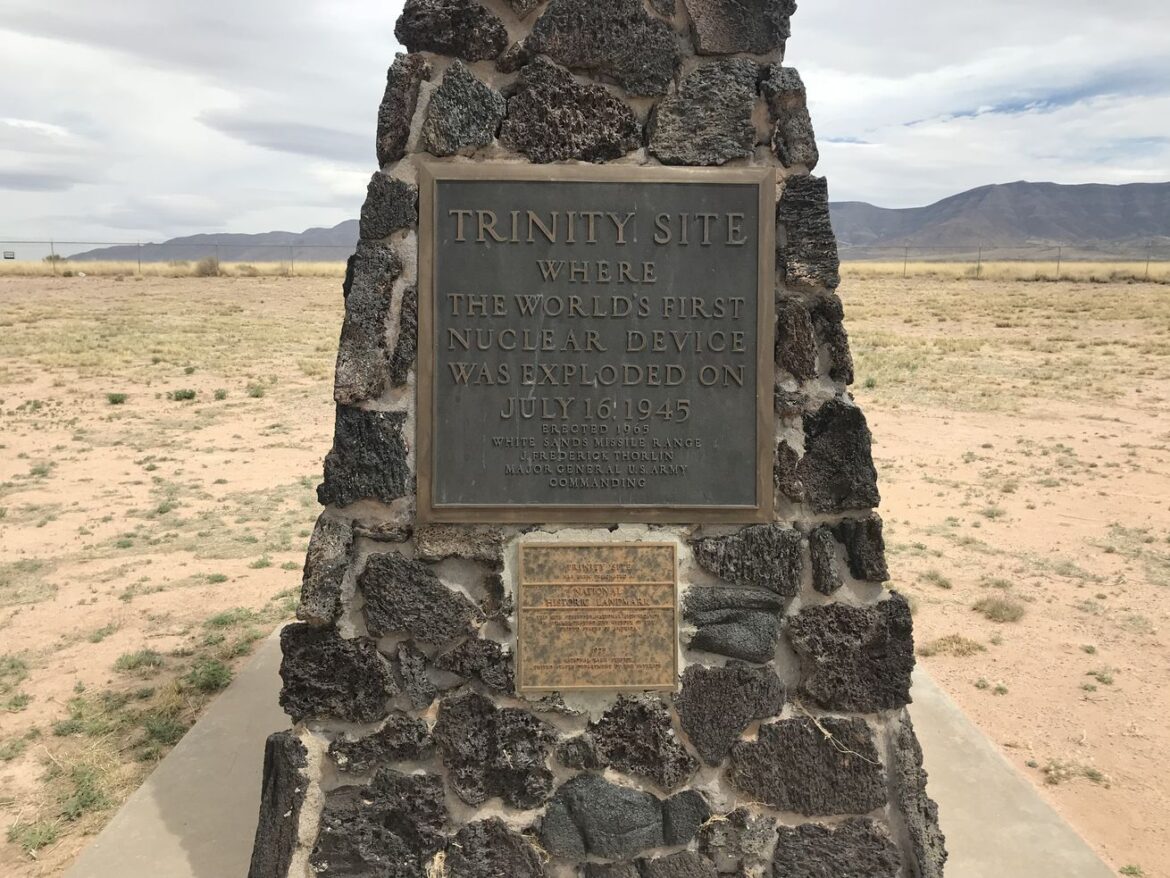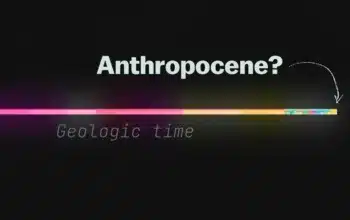Oppenheimer’s Trinity Site is where the end began.
To reach the spot where the nuclear age was born and human history swung, turn off of Route 380 at Stallion Gate on the northern edge of the US Army’s White Sands Missile Range, not far from the tiny desert town of Socorro, New Mexico. Drive through the flat, dry, empty scrub the Spanish called Jornada del Muerto, or the Journey of Death, ringed at the horizon by the Sierra Oscura, the Dark Mountains.
After 17 miles or so you’ll reach a vast parking lot that stands largely empty much of the year. Walk past a mangled 200-ton steel tube called Jumbo, and stand before a stone obelisk mined from nearby volcanic rock. The words on the plaque will tell you where you are: Trinity Site — where the world’s first nuclear device was exploded on July 16, 1945.
Trinity has largely faded from the public consciousness, overshadowed first by the horror of the atomic bombings of Hiroshima and Nagasaki, and later altogether as the fear of the bomb itself began to recede in the post-Cold War era. After World War II, the Interior Department tried to create a national monument at Trinity Site, but its efforts were continually frustrated by the military, which wanted to retain White Sands to test its growing inventory of missiles away from the public.
In truth, Americans have never known what to think about Trinity, simultaneously the greatest of technical and scientific achievements, the culmination of the Manhattan Project, and the birthplace of the first weapon of mass destruction, where the means to kill millions was tried and tested. It wasn’t until 1975 that Trinity Site was finally declared a National Historic Landmark — a few ranks down from a National Historical Park — and even now it remains largely closed to visitors, save for two Saturdays a year in April and October.
You can expect crowds to grow this fall, because the Trinity test is the hinge of Christopher Nolan’s hit biopic Oppenheimer, on the man behind the Manhattan Project. But what does it feel like to stand at the spot of Ground Zero, the site where, as Matt Damon’s General Leslie Groves says in the film: “the most important fucking thing to ever happen in the history of the world” actually happened?
The day the sun rose twice
I had a chance to visit Trinity Site myself in the spring of 2018, when I was researching my book End Times: A Brief Guide to the End of the World. I’m not sure what I expected as I broiled under the New Mexico sun. A moment of existential clarity? Some monument that represents the enormity of what happened here, the moment and the place where human beings demonstrated that they would now have the power to destroy themselves?
But save for a two-inch chunk of concrete left from the original tower, and the bits of glassy green called trinitite that were liquified in the blast before falling to the earth as hardened shards, there’s little indication at Trinity Site today of what occurred more than 70 years ago. And even the more immediate aftermath left some of the witnesses underwhelmed. A few weeks after the test, Gen. Groves, the director of the Manhattan Project and Oppenheimer’s boss, was driven out to the site on an observation trip. A Manhattan Project physicist remembered Groves looking at the crater left by the first atomic bomb and remarking: “Is that all?”
But no one who witnessed the day the sun rose twice ever forgot the experience, a fact ably captured in Nolan’s magisterial recreation of the event. The day of my visit to Trinity, frame-by-frame photos of the moments after the bomb’s detonation were arranged against the fence. Here’s how I described it in my book:
At 0.006 seconds there is a bubble of perfect light, as if the dawn itself had blossomed suddenly out of the desert ground. The heat of the blast is thousands of times hotter than the surface of the sun, and the light in that single moment was a dozen times brighter. At 0.025 seconds, the bubble head keeps rising, while a fringe of fire spreads across the ground…
At 0.053 seconds, that perfect bubble begins to lose its clarity, becoming diffused and unfocused, as if overwhelmed by its own energy, while the inferno at the surface expands, gouging out the earth below. At this point every living thing within a radius of a mile is dead, or will be soon.
At 0.10 seconds, the blast looks like nothing less than a halo on the head of some Renaissance painting of Christ, as the exposure itself begins to degrade. The atomic heat has made the air grow luminous, as the force of the shock wave expands outward, shredding the matter in its path. Everything is ravaged, everything is burned.
And at 15 seconds after detonation comes the familiar image of the mushroom cloud, what the art historian John O’Brian called “the logo of logos of the 20th century” … That mushroom cloud — like nothing seen on Earth before — is the result of intense heat at the heart of the blast, causing the air to rise in a column, before it spreads out in a mushroom’s cap.
In their definitive biography American Prometheus, the source material for Nolan’s film, Kai Bird and Martin J. Sherwin wrote that no one can know what flashed through the physicist’s mind as he beheld the thing that he, more than any other person, had willed into being. Oppenheimer’s brother Frank remembered that, “I think we just said, ‘It worked.’”
More than his words, it was Oppenheimer’s countenance in the aftermath that was telling, another moment Nolan captures perfectly. The Manhattan Project physicist Isidor Isaac Rabi recalled it this way: “I’ll never forget his walk. I’ll never forget the way he stepped out of the car…his walk was like High Noon…this kind of strut. He had done it.”
Yet the site of Trinity itself today contains nothing of this triumphalism, just as it has nothing to say about the tens of thousands of people who would be killed in a few short weeks by the descendants of that original bomb.
Was it a scientific victory? An unmitigated horror? All a visitor to Trinity has is their thoughts, a bare plaque, and the silent, endless desert that surrounds them.
Where the ending began
How should we remember Oppenheimer and Trinity? Far better than we do now. Despite Bird and Sherwin’s biography, which won the Pulitzer Prize in 2006, and Richard Rhodes’s equally great 1986 book The Making of the Atomic Bomb, which features Oppenheimer as a central character, both he and the test itself have received far less than their due. Oppenheimer wasn’t a president or a general, and while an excellent theoretical physicist, he was not among the 20-some scientists connected to the Manhattan Project who had already won or would go on to win a Nobel Prize.
And yet without Oppenheimer’s ability to motivate and corral fractious scientific egos, and the sheer drive that was a product of what Groves called his “overweening ambition,” the Manhattan Project would likely never have succeeded. And Trinity was the proof of that success. Nolan’s film goes a long way toward correcting that score.
But Oppenheimer’s success contained within it the seeds of its own destruction — something Oppenheimer himself, a lifelong student of Hindu thought, might have appreciated. At the end of the film, Oppenheimer is seen visiting Albert Einstein on the peaceful, leafy campus of the Institute for Advanced Study at Princeton, far removed from Trinity’s bare desert. Oppenheimer reminds the older scientist of an earlier conversation, when Manhattan Project physicists worried that a nuclear bomb might inadvertently ignite the atmosphere.
“When I came to you with those calculations, we thought we might start a chain reaction that might destroy the entire world,” Oppenheimer says.
“What of it?” Einstein replies.
“I believe we did,” Oppenheimer says.
What is Trinity Site? It is the place where those calculations were proven in nuclear fire, the Ground Zero where one possible end for us all began.



